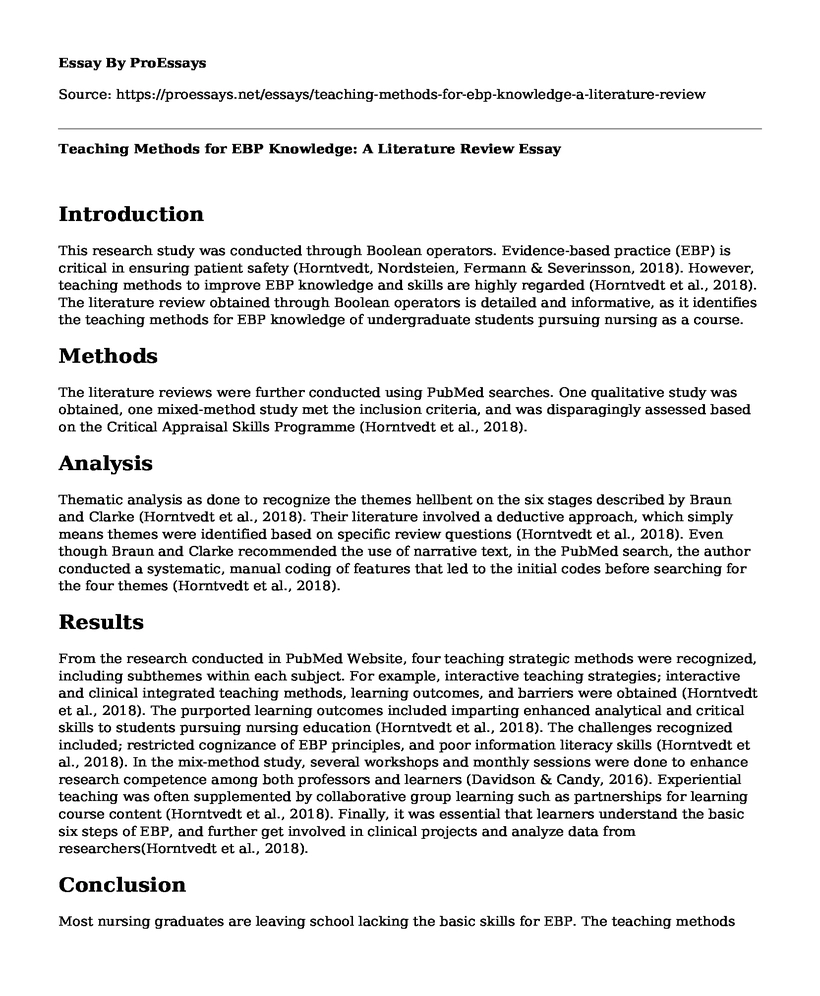Introduction
This research study was conducted through Boolean operators. Evidence-based practice (EBP) is critical in ensuring patient safety (Horntvedt, Nordsteien, Fermann & Severinsson, 2018). However, teaching methods to improve EBP knowledge and skills are highly regarded (Horntvedt et al., 2018). The literature review obtained through Boolean operators is detailed and informative, as it identifies the teaching methods for EBP knowledge of undergraduate students pursuing nursing as a course.
Methods
The literature reviews were further conducted using PubMed searches. One qualitative study was obtained, one mixed-method study met the inclusion criteria, and was disparagingly assessed based on the Critical Appraisal Skills Programme (Horntvedt et al., 2018).
Analysis
Thematic analysis as done to recognize the themes hellbent on the six stages described by Braun and Clarke (Horntvedt et al., 2018). Their literature involved a deductive approach, which simply means themes were identified based on specific review questions (Horntvedt et al., 2018). Even though Braun and Clarke recommended the use of narrative text, in the PubMed search, the author conducted a systematic, manual coding of features that led to the initial codes before searching for the four themes (Horntvedt et al., 2018).
Results
From the research conducted in PubMed Website, four teaching strategic methods were recognized, including subthemes within each subject. For example, interactive teaching strategies; interactive and clinical integrated teaching methods, learning outcomes, and barriers were obtained (Horntvedt et al., 2018). The purported learning outcomes included imparting enhanced analytical and critical skills to students pursuing nursing education (Horntvedt et al., 2018). The challenges recognized included; restricted cognizance of EBP principles, and poor information literacy skills (Horntvedt et al., 2018). In the mix-method study, several workshops and monthly sessions were done to enhance research competence among both professors and learners (Davidson & Candy, 2016). Experiential teaching was often supplemented by collaborative group learning such as partnerships for learning course content (Horntvedt et al., 2018). Finally, it was essential that learners understand the basic six steps of EBP, and further get involved in clinical projects and analyze data from researchers(Horntvedt et al., 2018).
Conclusion
Most nursing graduates are leaving school lacking the basic skills for EBP. The teaching methods obtained in the study suggest that interactive teaching methods are used alongside convectional lecturers to improve research application skills in nursing education (Davidson & Candy, 2016). Nevertheless, collaboration with clinical practice to improve EBP knowledge was dismally addressed in the study conducted through PubMed
References
Davidson, S. J., & Candy, L. (2016). Teaching EBP Using GameBased Learning: Improving the Student Experience. Worldviews on EvidenceBased Nursing, 13(4), 285-293. Retrieved from: https://www.ncbi.nlm.nih.gov/pubmed/27028987
Horntvedt, M. E. T., Nordsteien, A., Fermann, T., & Severinsson, E. (2018). Strategies for teaching evidence-based practice in nursing education: a thematic literature review. BMC medical education, 18(1), 172. Retrieved from: https://www.ncbi.nlm.nih.gov/pubmed/30055612
Cite this page
Teaching Methods for EBP Knowledge: A Literature Review. (2023, Mar 26). Retrieved from https://proessays.net/essays/teaching-methods-for-ebp-knowledge-a-literature-review
If you are the original author of this essay and no longer wish to have it published on the ProEssays website, please click below to request its removal:
- Teaching Strategies in Nursing Paper Example
- Essay Example on Working at Milford Health & Rehab: Enhancing Lives Through Quality Care
- Access to Water: Essential for Life & Public Health - Essay Sample
- Essay Example on New Sweet Odor in Diapers: Further Info Needed
- Essay Example on Asthma Management in Children: Home & Medical Collaboration
- Remote Area Nurses: Prevalent Victims of Occupational Violence Paper
- Free Paper Sample: HIV/AIDS Cases in Nigeria







